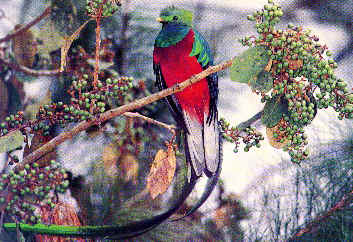
E-mail: font@focusonnature.com
Phone: Toll-free in USA 1-888-721-3555
or 302/529-1876
 |
PO Box 9021,
Wilmington, DE 19809, USA E-mail: font@focusonnature.com Phone: Toll-free in USA 1-888-721-3555 or 302/529-1876 |
 Guatemala
Birds
Guatemala
Birds
noting those during
Focus On Nature Tours
with an (*)
1991 thru 2015
during the months
of January,
February,
March, April, May,
June, July, December
A Guatemala bird list compiled by Armas Hill
Photo at upper right: the RESPLENDENT QUETZAL, the national bird of Guatemala
555 species of birds have
cumulatively been found during 16 FONT birding & nature tours in Guatemala. Two additional subspecies brings the following list to
557.
Codes:
hi: in the highlands, including:
the western
mountains, from Antigua north to Quetzaltenango,
including areas
of Lake Atitlan and Fuentes Georginas,
the highlands of Verapaz, including
the Biotopo del Quetzal
the (mountains) Sierra de las
Minas
lw: in the lowlands, including:
near the Caribbean Seacoast, along the
Rio Dulce,
the arid Motagua Valley (in eastern Guatemala),
and in the Pacific lowlands.
ps: the Pacific Slope of western Guatemala, a transitional subtropical
zone ranging from about 2500 feet to 5000 feet above sea level (above
that, up to 7000 ft considered highlands - hi)
pt: in the Peten region, including:
Tikal, and the road east to
Belize,
south of Flores, along the Rio
de la Pasion, and the areas
of the Reserva Aguateca dos Pilas and
the Ceibal National Park
gc: in Guatemala City
(t): a globally threatened or
rare species, designated by Birdlife International.
(t1): critical
(t2): endangered (t3): vulnerable
(nt): a near-threatened species
globally.
(i): an introduced species.
(GUr): rare in Guatemala
(ph): species with a photo in the FONT website
A fine book, "Jungle of the
Maya" has recently been published (in 2006) by the University of Texas
Press. In it, there some very good photographs of wildlife in Belize, and in
nearby Guatemala & Mexico. In the following lists, pages in that book with
photos of particular species are referred to with a (p. xx)
Links:
A List & Photo Gallery of Central America Birds, in 4 parts:
Part #1: Tinamous to Doves Part #2: Macaws to Woodpeckers
Part #3: Manakins to Thrashers Part #4: Thrushes to Buntings
Mammals during previous FONT Tours in Guatemala (with some photos)
A List & Photo Gallery of Central America Butterflies & Moths, in 6 parts
Guatemalan Amphibians & Reptiles (with some photos)
Previous FONT Guatemala Tour Highlights
Upcoming FONT Birding & Nature Tours in Central America, including Guatemala
Directory of Photos in this Website
Bird-List:
Taxonomy conforms to a large extent with
"The Howard & Moore Complete Checklist of the Birds of the World, the
3rd Edition (2003) and "A Guide to the Birds of Mexico & Northern Central
America" (1995), by Steve Howell & Sophie Webb.
![]()